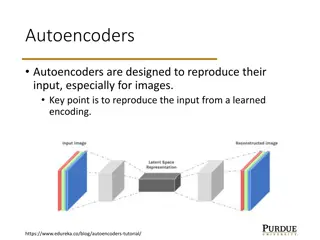Introduction to Latent Class Analysis with Dr. Oliver Perra
Explore the concept of Latent Class Analysis (LCA) through an introduction by Dr. Oliver Perra. Discover the main characteristics, goals, and assumptions of LCA along with an example problem. The provided data showcases patterns of low mood, loss of interest, fatigue, and sleep problems among a sample group, highlighting the application of LCA in research.
Download Presentation

Please find below an Image/Link to download the presentation.
The content on the website is provided AS IS for your information and personal use only. It may not be sold, licensed, or shared on other websites without obtaining consent from the author.If you encounter any issues during the download, it is possible that the publisher has removed the file from their server.
You are allowed to download the files provided on this website for personal or commercial use, subject to the condition that they are used lawfully. All files are the property of their respective owners.
The content on the website is provided AS IS for your information and personal use only. It may not be sold, licensed, or shared on other websites without obtaining consent from the author.
E N D
Presentation Transcript
Dr Oliver Perra o.perra@qub.ac.uk Introduction to Latent Class Analysis
Outline Example of a problem Main characteristics of Latent Class Analysis (LCA) Latent Class Analysis main goals and research questions Main assumptions
Low mood Loss of interest Low mood Fatigue Low mood Low mood Loss of interest Sleep problems Loss of interest Loss of interest Fatigue Fatigue Fatigue Sleep problems Sleep problems Sleep problems Low mood Low mood Low mood Loss of interest Loss of interest Loss of interest Fatigue Fatigue Fatigue Sleep problems Sleep problems Sleep problems Low mood Low mood Loss of interest Loss of interest Low mood Fatigue Fatigue Loss of interest Sleep problems Sleep problems Fatigue Sleep problems
Low mood Loss of interest Low mood Fatigue Low mood Low mood Loss of interest Sleep problems Loss of interest Loss of interest N = 195 Fatigue Fatigue Fatigue Sleep problems Sleep problems Sleep problems N = 103 N = 186 N = 59 Low mood Low mood Low mood Loss of interest Loss of interest Loss of interest Fatigue Fatigue Fatigue N = 162 Sleep problems Sleep problems Sleep problems N = 176 N = 36 Low mood Low mood Loss of interest Loss of interest Low mood Fatigue Fatigue N = 56 Loss of interest Sleep problems Sleep problems N = 65 Fatigue Sleep problems N = 78
Low mood Loss of interest Low mood Fatigue Low mood Low mood Loss of interest Sleep problems Loss of interest Loss of interest N = 195 Fatigue Fatigue Fatigue Sleep problems Sleep problems Sleep problems N = 103 N = 186 N = 59 Low mood Low mood Low mood Loss of interest Loss of interest Loss of interest Fatigue Fatigue Fatigue N = 162 Sleep problems Sleep problems Sleep problems N = 176 N = 36 Low mood Low mood Loss of interest Loss of interest Low mood Fatigue Fatigue N = 56 Loss of interest Sleep problems Sleep problems N = 65 Fatigue Sleep problems N = 78
Low mood Loss of interest Low mood Fatigue Low mood Low mood Loss of interest Sleep problems Loss of interest Loss of interest N = 195 Fatigue Fatigue Fatigue Sleep problems Sleep problems Sleep problems N = 103 N = 186 N = 59 Low mood Low mood Low mood Loss of interest Loss of interest Loss of interest Fatigue Fatigue Fatigue N = 162 Sleep problems Sleep problems Sleep problems N = 176 N = 36 Low mood Low mood Loss of interest Loss of interest Low mood Fatigue Fatigue N = 56 Loss of interest Sleep problems Sleep problems N = 65 Fatigue Sleep problems N = 78
Main Characteristics of Latent Class Analysis (LCA)
Main characteristics of Latent Class Analysis (LCA) Person-centred approach:
Main characteristics of Latent Class Analysis (LCA) Person-centred approach:
Main characteristics of Latent Class Analysis (LCA) Person-centred approach Measurement model Low mood Loss of interest Low mood Fatigue Loss of interest Sleep problems Fatigue Sleep problems
Main characteristics of Latent Class Analysis (LCA) Person-centred approach Measurement model Low mood Loss of interest Low mood Fatigue Loss of interest Sleep problems Fatigue Sleep problems Status: Depression Status: No Depression
Correlated indicators U1 U2 U3 U4
Correlated indicators Low Mood Sleep probs Lack of Pleasure Fatigue
Latent Class Model Depression No Depression Low Mood Sleep probs Lack pleasure Fatigue
Latent Class Model Depression No Depression Conditional independence: Observed variables are independent given latent class affiliation. Low Mood Sleep probs Lack pleasure Fatigue
Latent Class Analysis: Main goals and research questions
Main Goals of Latent Class Analysis Identify the number of categories necessary to explain differences in behaviour patterns Characterise these underlying categories based on their associations with observed behaviours
Example of Research: Grunow, Begall, & Buchler (2018). Gender Ideologies in Europe: A multidimensional framework. Journal of Marriage and Family (80), 42-60. DOI:10.1111/jomf.12453 Data from 2008 European Values Study (8 Countries; Over 5,000 participants) 7 Items: E.g.: Preschool child suffers with working mother Agree / Disagree Identified classes beyond unidimensional Egalitarian vs. Traditional distinction: E.g.: Egalitarian essentialists: Advocate similar roles for men and women But agree with Being housewife as fulfilling as paid job and Women really want home & children Ideologies mixing gender essentialist and egalitarian views appear to have replaced traditional ideologies, even in countries offering some institutional support for gendered separate spheres.
Example of Research: Grunow, Begall, & Buchler (2018). Gender Ideologies in Europe: A multidimensional framework. Journal of Marriage and Family (80), 42-60. DOI:10.1111/jomf.12453 Further questions LCA can answer: Egalitarian Essentialist Egalitarian Traditionalist Intensive parenting Moderate Traditionalist
Example of Research: Grunow, Begall, & Buchler (2018). Gender Ideologies in Europe: A multidimensional framework. Journal of Marriage and Family (80), 42-60. DOI:10.1111/jomf.12453 Further questions LCA can answer: Factors influencing individuals affiliation to different classes: Does class affiliation vary by country? Does it vary according to Socio-Economic Status? Egalitarian Essentialist Country Egalitarian Traditionalist SES Intensive parenting Moderate Traditionalist
Example of Research: Grunow, Begall, & Buchler (2018). Gender Ideologies in Europe: A multidimensional framework. Journal of Marriage and Family (80), 42-60. DOI:10.1111/jomf.12453 Further questions LCA can answer: Factors that influence the probability of being in different classes Do latent classes relate to other behaviours? E.g. Do attitudes to gender roles predict intentions to vote in referenda on issues such as abortion regulations? Egalitarian Essentialist Country Egalitarian Traditionalist SES Vote in referendum Intensive parenting Moderate Traditionalist
Main assumption of LCA Latent classes: Mutually exclusive: an individual belongs to just one class; Exhaustive: All individuals belong to one class. Status: Status: Depressed Not Depressed
Main assumption of LCA Individuals within each class have the same propensity to display indicator behaviours Observed intra-classes differences due to error variation Intra-group homogeneity Inter-group heterogeneity Status: Status: Depressed Not Depressed Low mood Low mood Loss of interest Loss of interest Fatigue Fatigue Sleep problems Sleep problems
Main assumption of LCA Membership to latent classes is assessed with uncertainty 66% 96% 89% Status: 82% Status: Depressed 63% Not Depressed 97% 84% 56% 57% 78% 72% 58% 82%
Summary: Latent Class Analysis ( Summary: Latent Class Analysis (LCA LCA) ) Person centred-approach Investigates mixture of individuals in a sample: How many categories adequately explain observed behaviour variation Categorise individuals into only one category Measurement model: Observed behaviours are causally related to underlying categorical differences, e.g. Disordered / Non-Disordered; Egalitarian / Egalitarian Essentialist / Traditionalist / Allows identification of qualitative differences between individuals: E.g.: Multi-dimensional gender ideologies beyond the Egalitarian / Traditionalist views























